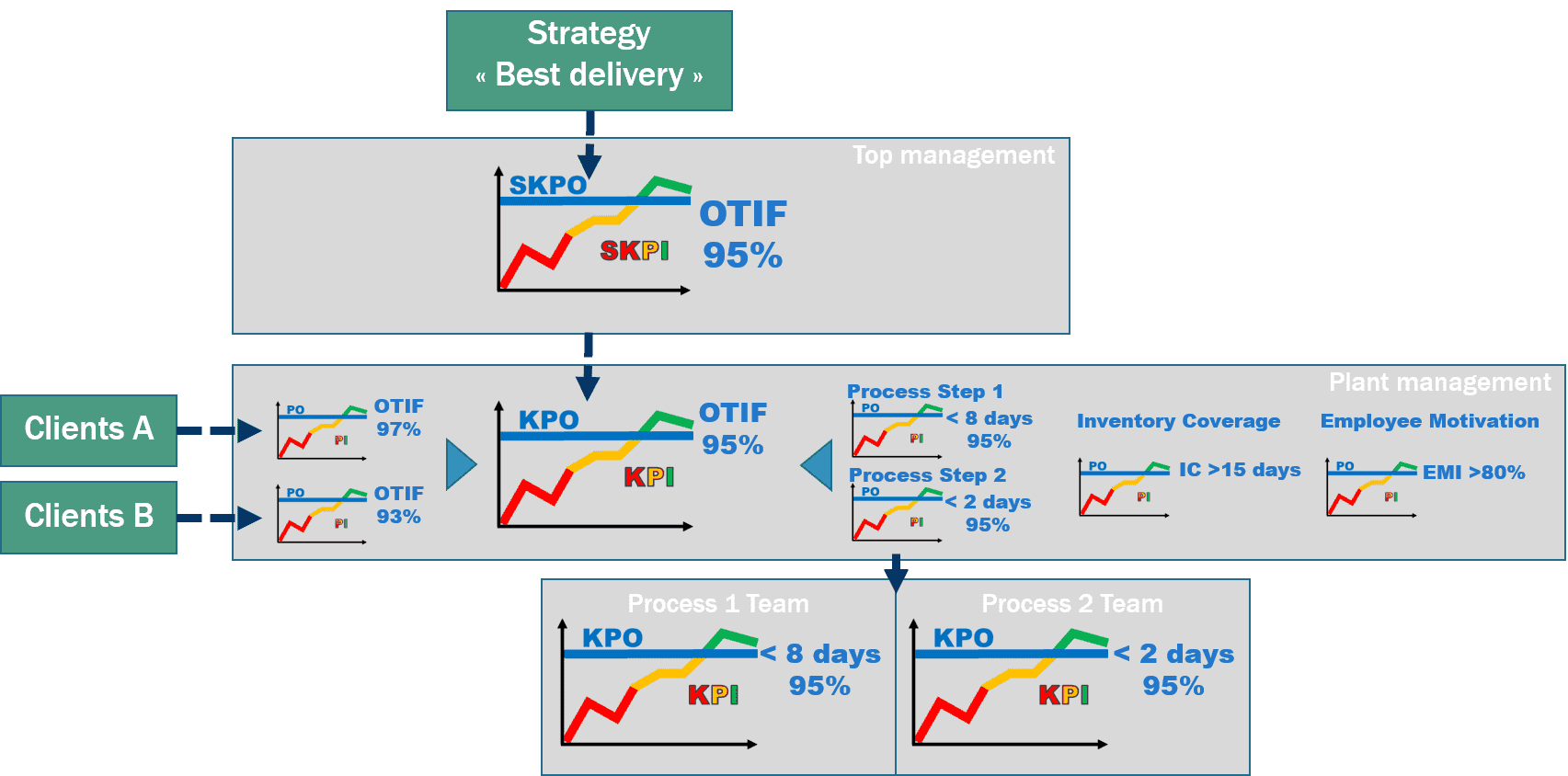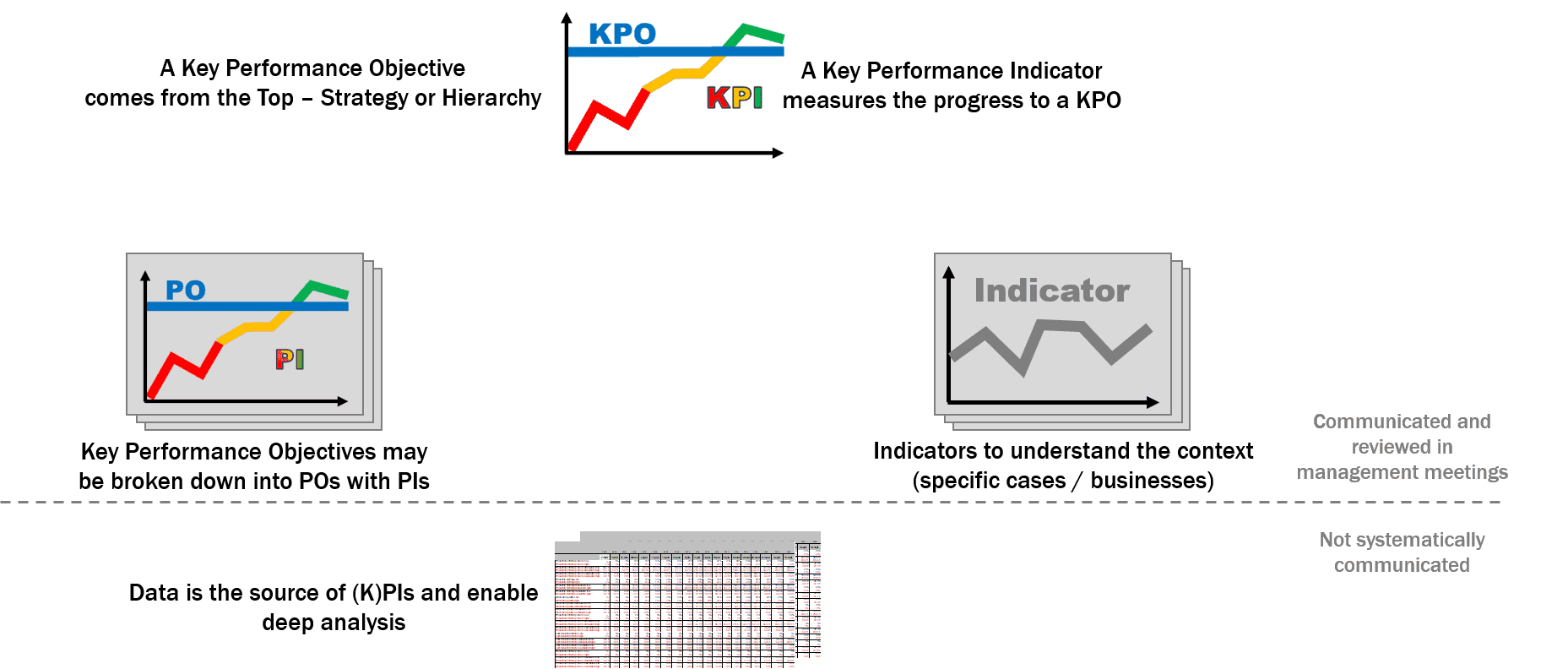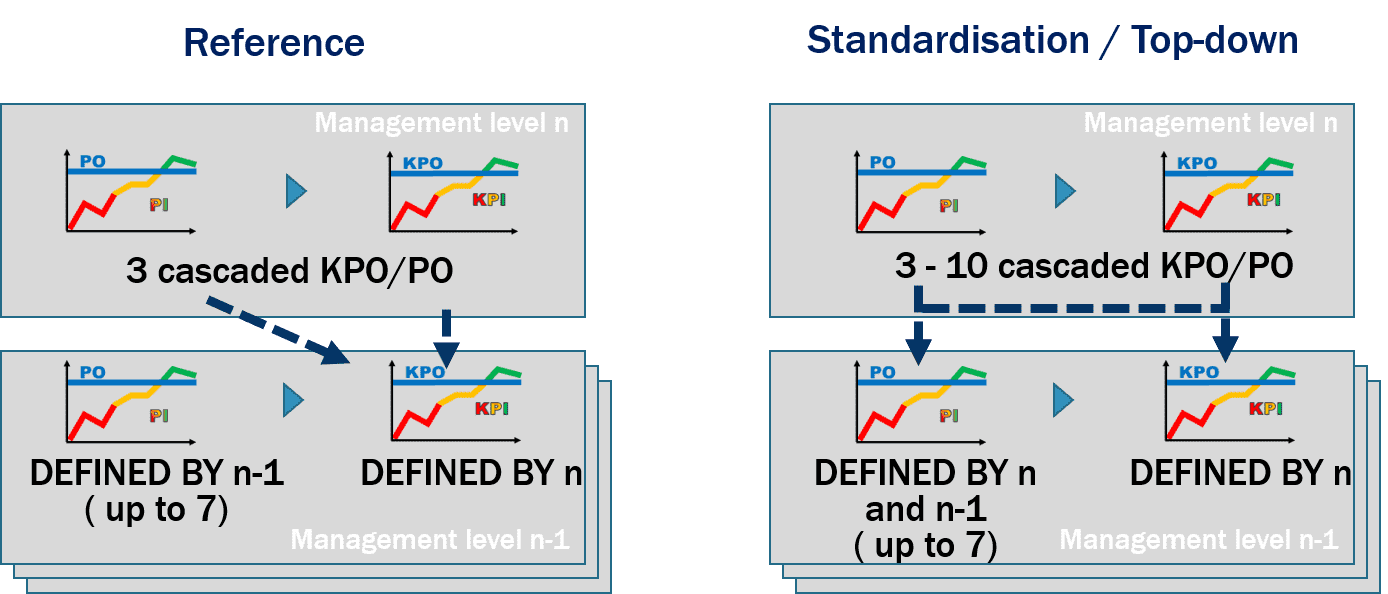Why should we talk about KPO and not KPI and make the K useful?
Defining performance indicators is unfortunately more important than defining the right objectives
"KPI" is one of the most searched word in the Business world with 163 000 searches / month according to Google Ads. There are thousands of sites giving you all the answers needed. However, some answers are difficult to find, others are inconsistent, and some topics are somewhat blurry or not really addressed.Examples?
- How many KPIs should we have? That is a very common and difficult question with many answers. Most answers you find are around 3 to 5 though it might go up to 10, as in a white paper published by worldwide top management consulting firm.
- What is exactly a KPI? Especially how does it differ from a normal Performance Indicator, a simple PI? It seems like Performance Indicators don’t exist, only Key ones do, whether in the internet, or in ‘real’ Business (as seen during more than 20 years of experience in operational excellence diagnostics). So why ‘Key’ in Key Performance Indicator?
- Yes, objectives are often stated as prerequisites to build KPIs but in our views, the focus remains too much on KPIs and not enough on KPOs (Key Performance Objectives). Again, in real life, we have often seen managers trying to find an objective for a KPI rather than better defining the objectives first, in a “the tail wags the dog” way. Some numbers to consider (according to Google search):
- 40 500 searches/month on Key Performance Indicators on Google;163 000 searches/month on KPI with only 2 results not linked to Key Performance Indicators in the first ten pages (and after the 6th page)
- 210 searches/month on Key Performance Objectives; 33 100 searches/month on KPO but you don’t find any answer related to key Performance Objectives (I stopped googling until I reached ‘Kpo the Panther’ on the 10th page, 90% of the results being about Key Process Outsourcing)
- What is the relationship between the ‘top management team’ KPIs and the other teams’ KPIs below? And are they KPIs or PIs; how do they derive from the management team KPIs? Though many sites address, somewhat, how to cascade the KPIs, the focus remains on the ‘top management team’; these questions are hardly addressed.
The goal of this article is to try to fill some of these gaps and give some recommandations learnt from our experience.
1 Everything starts from Key Performance Objectives (KPO)
There is no compromise: a KPI can’t exist without a Key Performance Objective (KPO); or it is not a KPI.
In a nutshell, a KPO is an objective that comes from the ‘Top’. There are two situations:
- For the top management team, the ‘Top’ is the strategy, and therefore the KPO is a strategic objective (a SKPO), defined in the strategy, which obviously must exist, even if not elaborate.
- For any team at lower hierarchical level, we define that their KPOs are the objectives coming from their hierarchy
The KPI is obviously the measure monitoring the progress towards the KPO.
2 ‘Simple’ Performance Objectives and Performance Indicators exist; they are not KPOs and KPIs but support them
Simple Performance Objectives and Indicators support the values of a KPO or a KPI; they are always less important or on a smaller scope than their related KPO or KPI.
There are two main types of PO and PIs:
- the ‘breakdown’ PO/PI: it is a mathematical breakdown of a KPO/KPI into several ‘smaller scope’ performance indicators, meaning that they can be added up to calculate the overall KPO/KPI:
- breakdown by product or service, by geography, by type of client, by plant…
- breakdown by subprocess
- the ‘enabling’ PO/PI: it measures a driver that is believed to be supporting the achievement of one or several KPO/KPIs; it is not directly linked to a KPO/KPI. The value of the PO is often defined or refined after some experimentation as opposed to the ‘breakdown’ ones that are more driven by the KPO they support
There may be other Indicators that are tracked to understand the context or to facilitate the analysis of a KPI behaviour e.g. why does it change. And they don’t have an associated PO. They are in general external parameters that can’t really be controlled, so they are not Performance Indicators, only Indicators. For example, an Ice Cream seller would obviously need to track the weather temperature to compare his sales performance over several time periods.
Let’s describe a simplistic example at this stage. The BestCompany designs, produces, and sells one product to two client segments, CA and CB, with two local units. One of its strategy is to have the most reliable delivery in its markets. It defined a strategic objective, SKPO, of 95% On Time In Full delivery (OTIF).
To simplify, we assume the two client segments buy with the same volume and we will only look at the cascading to the unit 1.
The management of the unit 1 gets the OTIF SKPO cascaded, becoming a KPO for the team. However, in its market, the clients CA and CB have different service level agreements, both with a lead time of 10 days; so, the team defines two different OTIF objectives:
- POa of 97%
- POb of 93%
The full process to deliver a product to a client is a two-step process, each managed by a different team:
- Step 1: Order to Production start, with a lead time of 8 days
- Step 2: Production start to Delivery, with a lead time of 2 days
The management team defines two more POs (to simplify they are the same for the clients A and B)
- POs1=below 8 days 95% of the time for step 1
- POs2 =below 2 days 95% of the time for step 2
It has identified (or it believes in) two other factors, important to the performance of the plant:
- its Employee motivation, that is measured regularly through a survey with a PI called Employee Motivation Index (EMI), with an objective (PO) of 80%.
- in the manufacturing process, some of the Products parts have a long lead time to supply so they have set an Inventory Coverage (IC) objective of 15 days.
Example Illustration

In this example, we have:
- some ‘breakdown’ KPO/KPI, the OTIFs and the Step 1 and Step 2 internal OTIFs (though statistically their ‘addition’ is more complex)
- two ‘enabling’ PO, the Inventory Coverage and the Employee Motivation
- some KPO/KPI or PO/PI are cascaded down, others not
We may think that a middle management team KPOs may also come from its own market or clients. However, if the Top management team SKPOs are well defined, the client objectives should be included in the cascaded KPOs; this is the case in the example.
So, the general model is illustrated below.

3 Define SMART objectives
A widely accepted rule for an objective is that it must be SMART; we fully adhere to this principle, with some of our own recommendations. The five letters mean:
- Specific: the objective must be specific and very clearly defined
- Measurable: the progress towards the objective must be measurable. In most cases, it means that it can be quantified. However, it might be sometimes difficult, and it is simpler, while still being effective to have at least a clear definition of how to evaluate the level of performance. As a rule of thumb, 80% of the objectives should be quantified.
- Attainable: the objective can be achieved realistically. We add, that the organisation must constantly improve and be ahead of its competition, which should be reflected in objectives that are also Ambitious and Adapted when the environment changes (or when the objectives are met). However, it doesn’t mean that every objective should be pushed up otherwise that may be detrimental to the work and people conditions; that’s part of the management challenge to choose when and which objective should be adapted, up or down.
- Relevant: the objective must be relevant to the organisation, by being aligned to the strategy and the practice or process it measures
- Time-related: the time-frame to achieve the objective must be clear
4 Should the Objectives be Balanced?
The Balanced Scorecard, originally developed by Dr. Robert Kaplan of Harvard University and Dr. David Norton, has been widely adopted. It is a framework for measuring organizational performance using a more balanced set of performance measures with four perspectives:
- Financial or Stewardship: financial performance or effective use of resources
- Customer/Stakeholder: Customer value and satisfaction
- Internal Process: efficient and quality processes
- Organisational Capacity or Learning and Growth: human assets and culture, Infrastructure and technology
In general, the two first dimensions (Financial/Stewardship) are lagging Strategic Key Performance Objectives and the two other ones are leading Performance Objectives. We believe this is a good framework to use when defining the KPOs and especially the supporting POs. However, it doesn’t mean that all four dimensions must be present for each team, in particular when cascaded down to teams that can’t have an influence on some of them.
To know more, click on About-the-Balanced-Scorecard
5 It is important to have both KPIs and PIs, but how many?
Having a very limited number of KPIs is a matter of focus and priority. It is difficult for a ‘normal’ human being to manage more than 3 objectives or priorities at the same time.
However, having 3 objectives only doesn’t feel enough to embrace the complexity of businesses.
In addition, we believe, as many studies have shown, that the objectives drive not only the Business results, but also the behaviours of the people. And we, as people, ‘play’ with them for our own benefits, and not necessarily for the benefits of the company. So, there might be a tendency to add more KPIs to ‘compensate’ some of the bias or potential poor consequences of some KPI. But then, confusion and loss of focus happens.
That is why the K is important; when it really is a K.
And when many say that there should be 3, or 5… or up to 10, we believe the number of KPIs should be 3, and then up to 7 more PIs. Provided the PIs support the KPIs and are less important than the KPIs.
That enables both the focus and the coverage of the business complexity.
6 A PI or a KPI is formally communicated and reviewed in focused systematic management meetings; other indicators are data
“Only 3 KPIs, but I have +100 products/customers… to deliver per week and I need to deliver them all!”
How many times have you seen management meeting ‘dashboards’ that are in fact Excel sheet extracts with the list of products/services volume sold?
Yes, all the orders must be delivered, all products must be produced…But that doesn’t mean they are Performance Indicators.
We define that one key feature of a Performance Indicator is that it is formally communicated and reviewed in focused systematic management meetings (all words matter in the sentence). That means there can only be a few indicators; otherwise they can’t be reviewed in a focused and systematic meeting. The remaining ones, even though important, are ‘data’ for the management team. When there are many products, services, processes… the (common) challenge is to build consolidated or compound KPIs that enable to have a manageable set of KPIs representing the overall performance. And when one KPO isn’t reached (or the farthest from being reached), then the management can drill down to more data, or delegate the analysis to the lower management level.
What is considered as a (K)PI, simple indicator and data as regards to the communication is illustrated below.

7 Leading indicators are the essence of management
There are Lagging and Leading indicators:
- A lagging indicator typically measures an output, a result. It measures something that has happened and cannot be changed any more. In our example, all the OTIF KPIs are lagging indicator, whether they measure the progress towards the strategic objective of 95%, the client segment objectives or the process step ones.
- A leading indicator typically measures an input, or a catalyst. It measures something that when present at the right level is favourable to the achievement of the lagging indicator. It is a predictor, though imperfect of the result. Actually, the leading indicators measure the real business drivers the that need to be managed by the managers. In our example, the Employee Motivation and the Inventory Coverage are leading indicators. In a sales team, the number of client meetings of a sales manager is a business driver and is likely to predict its sales performance; but it is imperfect because if the client meetings are poorly executed (or with the wrong clients), then the performance will still be poor no matter the number of meetings.
Thus, by definition, lagging indicators always exist, since they are at least the strategic objectives or the financial ones.
And leading indicators should exist; any business manager should identify the performance drivers, define and manage his leading indicators because it is just the essence of management.
From the example we can notice, and this is a general rule:
- except the Strategic KPIs that are mostly lagging indicators, KPIs may indifferently be leading or lagging.
- the ‘enabling’ PIs are always leading, while the ‘breakdown’ PIs may be leading or lagging
8 What KPO or PO to cascade down, how many and how?
The KPO or PO that can be cascaded are the ones that are managed and are Actionable by the team ‘receiving’ them. A team or an individual should only have objectives that are totally under their control. However, there are two situations where the objectives are somewhat ‘shared’, without a team having full control on them:
- defining shared objectives may be done on purpose to encourage team spirit and collaboration.
- it is not always easy to have an obvious indicator direct break down and clearly separate the accountabilities; there may not be a simple mathematical formula
Nonetheless, the number of these shared objectives should be limited to keep individuals, or teams, accountable for some specific scopes.
The ‘how many’ should be easy, since a cascaded KPO or PO becomes a KPO for the team below, it should be 3! However, this is not that true for two main reasons:
- Large organisations often need to have standard KPIs and PIs used at different hierarchical levels throughout the organisation. So not only the KPO/KPIs are standard and cascaded, but also the PI/and PO; we call that the ‘standardisation’ case in the figure below
- Similarly, even for smaller organisation, some cascaded down KPOs or POs may not actually be KPOs (which in theory they should all be) for the team below, but supporting POs of some of the other cascaded KPOs. However, that should be very clearly communicated so that there is a clear priority between the different objectives cascaded down. In reality, that is equivalent to have 3 KPOs for the team (coming from above), but with all or part of the remaining 7 POs defined by the team above (and not by the team receiving the KPOs; we call that the ‘top-down’ case in the figure below
The figure below illustrates the difference between the pure ‘reference’ case and the Standardisation or Top Down case

The ‘how’ is the most difficult part, especially in the Standardisation or Top Down case. Because a ‘good’ KPI or PI is one that is managed and useful. Specially for the team ‘receiving’ the KPI/PI. That seems very obvious, but we can’t count the situations in which we have observed that the ‘n-1’ management team must report KPIs they don’t really understand or must ‘use’ PIs they actually don’t really use, but just report; the result being that the reported KPI/PI are often unreliable, the ‘n-1’ team creates other ‘parallel’ PIs to manage its operation, or worse does not really use any KPI.
In the definition phase (as well as in update phases), we believe there is no other way to involve substantially the ‘n-1’ teams in the definition of the KPI/PI, which may be a consequent task for large organisations.
During the operations life, the ‘level n teams’ must themselves manage the KPIs reported and demonstrate it consistently to the ‘level n-1 teams’. So that the ‘level n-1 teams’ understand better the purpose and are more motivated to report and use the KPI/PIs.
When you subscribe to the blog, we will send you an e-mail when there are new updates on the site so you wouldn't miss them.




Comments